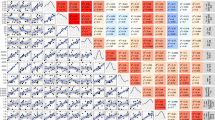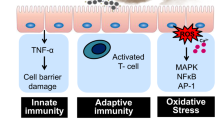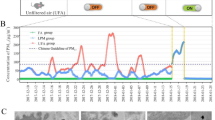Abstract
First responders (FRs) present at Ground Zero within the critical first 72 h after the World Trade Center (WTC) collapse have progressively exhibited significant respiratory injury. The majority (>96%) of WTC dusts were >10 μm and no studies have examined potential health effects of this size fraction. This study sought to develop a system to generate and deliver supercoarse (10–53 μm) WTC particles to a rat model in a manner that mimicked FR exposure scenarios. A modified Fishing Line generator was integrated onto an intratracheal inhalation (ITIH) system that allowed for a bypassing of the nasal passages so as to mimic FR exposures. Dust concentrations were measured gravimetrically; particle size distribution was measured via elutriation. Results indicate that the system could produce dusts with 23 μm mass median aerodynamic diameter (MMAD) at levels up to ≥1200 mg/m3. To validate system utility, F344 rats were exposed for 2 h to ≈100 mg WTC dust/m3. Exposed rats had significantly increased lung weight and levels of select tracer metals 1 h after exposure. Using this system, it is now possible to conduct relevant inhalation exposures to determine adverse WTC dusts impacts on the respiratory system. Furthermore, this novel integrated Fishing Line–ITIH system could potentially be used in the analyses of a wide spectrum of other dusts/pollutants of sizes previously untested or delivered to the lungs in ways that did not reflect realistic exposure scenarios.
This is a preview of subscription content, access via your institution
Access options
Subscribe to this journal
Receive 6 print issues and online access
$259.00 per year
only $43.17 per issue
Buy this article
- Purchase on Springer Link
- Instant access to full article PDF
Prices may be subject to local taxes which are calculated during checkout




Similar content being viewed by others
References
Lioy PJ, Weisel CP, Millette JR, Eisenreich S, Vallero D, Offenberg J et al. Characterization of the dust/smoke aerosol that settled east of the World Trade Center (WTC) in lower Manhattan after the collapse of the WTC 11 September 2001. Environ Health Perspect 2002; 110: 703–714.
McGee JK, Chen LC, Cohen MD, Chee GR, Prophete CM, Haykal-Coates N et al. Chemical analysis of World Trade Center fine particulate matter for use in toxicologic assessment. Environ Health Perspect 2003; 111: 972–980.
Landrigan PJ, Lioy PJ, Thurston G, Berkowitz G, Chen LC, Chillrud SN et al. Health and environmental consequences of the World Trade Center disaster. Environ Health Perspect 2004; 112: 731–739.
Lorber M, Gibb H, Grant L, Pinto J, Pleil J, Cleverly D . Assessment of inhalation exposures and potential health risks to the general population that resulted from the collapse of the World Trade Center towers. Risk Anal 2007; 27: 1203–1221.
CDC (Centers for Disease Control). Injuries and illnesses among New York City Fire Department rescue workers after responding to the World Trade Center attacks. MMWR 2002; 51: 1–5.
Edelman P, Osterloh J, Pirkle J, Caudill SP, Grainger J, Jones R et al. Biomonitoring of chemical exposure among New York City firefighters responding to the World Trade Center fire and collapse. Environ Health Perspect 2003; 111: 1906–1911.
Banauch GI, Dhala A, Alleyne D, Alva R, Santhyadka G, Krasko A et al. Bronchial hyperreactivity and other inhalation lung injuries in rescue/recovery workers after the World Trade Center collapse. Crit Care Med 2005; 33 (S1): S102–S106.
Herbert R, Moline J, Skloot G, Metzger K, Baron S, Luft B et al. The World Trade Center disaster and the health of workers: five-year assessment of a unique medical screening program. Environ Health Perspect 2006; 114: 1853–1858.
Webber MP, Gustave J, Lee R, Niles JK, Kelly K, Cohen HW et al. Trends in respiratory symptoms of firefighters exposed to the World Trade Center disaster: 2001-2005. Environ Health Perspect 2009; 117: 975–980.
Feldman DM, Baron SL, Bernard BP, Lushniak BD, Banauch G, Arcentales N et al. Symptoms, respirator use, and pulmonary function changes among New York City firefighters responding to the World Trade Center disaster. Chest 2004; 125: 1256–1264.
Prezant DJ, Weiden M, Banauch GI, McGuinness G, Rom WN, Aldrich TK et al. Cough and bronchial responsiveness in firefighters at the World Trade Center site. New Engl J Med 2002; 347: 806–815.
Banauch GI, Alleyne D, Sanchez R, Olender K, Cohen HW, Weiden M et al. Persistent hyper-reactivity and reactive airway dysfunction in firefighters at the World Trade Center. Am J Respirr Crit Care Med 2003; 168: 54–62.
CDC (Centers for Disease Control). Physical health status of World Trade Center rescue and recovery workers and volunteers—New York City, July 2002-August 2004. MMWR 2004; 53: 807–812.
Wheeler K, McKelvey W, Thorpe L, Perrin M, Cone J, Kass D et al. Asthma diagnosed after 11 September 2001 among rescue and recovery workers: findings from the World Trade Center Health Registry. Environ Health Perspect 2007; 115: 1584–1590.
Antao VC, Pallos LL, Shim YK, Sapp JH, Brackbill RM, Cone JE et al. Respiratory protective equipment, mask use, and respiratory outcomes among World Trade Center rescue and recovery workers. Am J Indust Med 2011; 54: 897–905.
Salzman SH, Moosavy FM, Miskoff JA, Friedmann P, Fried G, Rosen MJ . Early respiratory abnormalities in emergency services police officers at the World Trade Center site. J Occup Environ Med 2004; 46: 113–122.
Buyantseva LV, Tulchinsky M, Kapalka GM, Chinchilli VM, Qian Z, Gillio R et al. Evolution of lower respiratory symptoms in New York police officers after 9/11: a prospective longitudinal study. J Occup Environ Med 2007; 49: 310–317.
Mendelson DS, Roggeveen M, Levin SM, Herbert R, de la Hoz RE . Air trapping detected on end-expiratory high-resolution computed tomography in symptomatic World Trade Center rescue and recovery workers. J Occup Environ Med 2007; 49: 840–845.
Oppenheimer BW, Goldring RM, Herberg ME, Hofer IS, Reyfman PA, Liautaud S et al. Distal airway function in symptomatic subjects with normal spirometry following World Trade Center dust exposure. Chest 2007; 132: 1275–1282.
de la Hoz RE, Shohet MR, Chasan R, Bienenfeld LA, Afilaka AA, Levin SM et al. Occupational toxicant inhalation injury: World Trade Center (WTC) experience. Int Arch Occup Environ Health 2008; 81: 479–485.
Prezant DJ . World Trade Center Cough Syndrome and its treatment. Lung 2008; 186 (S1): S94–102.
Szeinuk J, Padilla M, de la Hoz RE . Potential for diffuse parenchymal lung disease after exposures at World Trade Center disaster site. Mt Sinai J Med New York 2008; 75: 101–107.
Rom WN, Reibman J, Rogers L, Weiden MD, Oppenheimer B, Berger K et al. Emerging exposures and respiratory health: World Trade Center dust. Proc Am Thorac Soc 2010; 7: 142–145.
Skloot G, Goldman M, Fischler D, Goldman C, Schechter C, Levin S et al. Respiratory symptoms and physiologic assessment of ironworkers at the World Trade Center disaster site. Chest 2004; 125: 1248–1255.
Izbicki G, Chavko R, Banauch GI, Weiden MD, Berger KI, Aldrich TK et al. World Trade Center “sarcoid-like” granulomatous pulmonary disease in New York City Fire Department rescue workers. Chest 2007; 131: 1414–1423.
Weakley J, Webber MP, Gustave J, Kelly K, Cohen HW, Hall CB et al. Trends in respiratory diagnoses and symptoms of firefighters exposed to the World Trade Center disaster: 2005-2010. Prevent Med 2011; 53: 364–369.
Weiden MD, Ferrier N, Nolan A, Rom WN, Comfort A, Gustave J et al. Obstructive airways disease with air trapping among firefighters exposed to World Trade Center dust. Chest 2010; 137: 566–574.
Nolan A, Naveed B, Comfort AL, Ferrier N, Hall CB, Kwon S et al. Inflammatory biomarkers predict airflow obstruction after exposure to World Trade Center dust. Chest 2011; 142: 412–418.
Zeig-Owens R, Webber MP, Hall CB, Schwartz T, Jaber N, Weakley J et al. Early assessment of cancer outcomes in New York City firefighters after the 9/11 attacks: an observational cohort study. Lancet 2011; 378: 898–905.
Kim H, Herbert R, Landrigan P, Markowitz SB, Moline JM, Savitz DA et al. Increased rates of asthma among World Trade Center disaster responders. Am J Indust Med 2012; 55: 44–53.
Offenberg JH, Eisenreich SJ, Chen LC, Cohen MD, Chee G, Prophete C et al. Persistent organic pollutants in the dusts that settled across lower Manhattan after September 11, 2001. Environ Sci Technol 2003; 37: 502–508.
USEPA (United States Environmental Protection Agency EPA). Exposure and Human Health Evaluation of Airborne Pollution from the World Trade Center Disaster (External Review Draft). EPA/600/R-02/002A 2002.
USEPA (United States Environmental Protection Agency EPA) EPA’s Response to the World Trade Center Collapse: Challenges, Successes, and Areas for Improvement. Evaluation Report Report No 2003-P-00012 2003.
USGS (United States Geological Service) Clark R, Plumlee G, Meeker G, Swayze G Environmental Studies of the World Trade Center Area, New York City, After September 11, 2001. USGS Fact Sheet 050-02 2002.
Gavett SH . World Trade Center fine particulate matter–chemistry and toxic respiratory effects: an overview. Environ Health Perspect 2003; 111: 971.
Olson DA, Norris GA, Landis MS, Vette AF . Chemical characterization of ambient particulate matter near the World Trade Center: elemental carbon, organic carbon, and mass reconstruction. Environ Sci Technol 2004; 38: 4465–4473.
Lowers HA, Meeker GP, Lioy PJ, Lippmann M . Summary of the development of a signature for detection of residual dust from collapse of the World Trade Center buildings. J Expo Sci Environ Epidemiol 2009; 19: 325–335.
Holma B, Lindegren M, Andersen JM . pH effects on ciliomotility and morphology of respiratory mucosa. Arch Environm Health 1977; 32: 216–226.
Gaafar H, Girgis R, Hussein M, el-Nemr F . The effect of ammonia on the respiratory nasal mucosa of mice. A histological and histochemical study. Acta Otolaryngol 1992; 112: 339–342.
Toren K, Brisman J, Hagberg S, Karlsson G . Improved nasal clearance among pulp-mill workers after the reduction of lime dust. Scand J Work Environ Health 1996; 22: 102–107.
Clary-Meinesz C, Mouroux J, Cosson J, Huitorel P, Blaive B . Influence of external pH on ciliary beat frequency in human bronchi and bronchioles. Eur Resp J 1998; 11: 330–333.
Ledbetter AD, Killough PM, Hudson GF . A low-sample-consumption dry-particulate aerosol generator for use in nose-only inhalation exposures. Inhal Toxicol 1998; 10: 239–251.
Hesterberg TW, McConnel EE, Miiller WC, Chevalier J, Everitt J, Thevenaz P et al. Use of lung toxicity and lung particle clearance to estimate the maximum tolerated dose (MTD) for a fiber glass chronic inhalation study in the rat. Fundam Appl Toxicol 1996; 32: 31–44.
Oberdorster G, Cox C, Gelein R . Intratracheal instillation versus intratracheal-inhalation of tracer particles for measuring lung clearance function. Exp Lung Res 1997; 23: 17–34.
Maciejczyk PB, Zeisler RL, Hwang JS, Thurston GD, Chen LC . Characterization of size-fractionated World Trade Center dust and estimation of relative dust contribution to ambient particulate concentrations. Urban Aerosols and Their Impacts. American Chemical Society, ACS symposium series 2005; Vol. 919, pp 114–131.
Prophete C, Maciejczyk P, Salnikow K, Gould T, Larson T, Koenig J et al2006 Effects of PM-associated metals on alveolar macrophage phosphorylated ERK-1 and -2 and iNOS expression during ongoing alteration in iron homeostasis. J Toxicol Environ Health 2006; 69: 935–951.
Osier M, Oberdorster G . Intratracheal inhalation vs. intratracheal instillation: differences in particle effects. Fundam Appl Toxicol 1997; 40: 220–227.
Elder A, Johnston C, Gelein R, Finkelstein J, Wang Z, Notter L et al. Lung inflammation induced by endotoxin is enhanced in rats depleted of alveolar macrophages with aerosolized clodronate. Exp Lung Res 2005; 31: 527–546.
Geyh AS, Chillrud S, Williams DL, Herbstman J, Symons JM, Rees K et al. Assessing truck driver exposure at the World Trade Center disaster site: personal and area monitoring for particulate matter and volatile organic compounds during October 2001 and April 2002. J Occup Environ Hyg 2005; 2: 179–193.
Vaughan JM, Garrett BJ, Chen LC, Cohen MD . A fishing line generator to deliver WTC dust particles for inhalation exposure. Toxicologist 2011, 269.
Taylor JK (ed) 1990 Statistical Techniques for Data Analysis. Lewis Publishers: Chelsea, MI.
Jarabek AM, Asgharian G, Miller FJ . Dosimetric adjustments for interspecies extrapolation of inhaled poorly soluble particles (PSP). Inhal Toxicol 2005; 17: 317–334.
Gibbs L, Aldrich TK, Cohen MD, Difede J, Gelberg KH, Greene C et al(World Trade Center Medical Working Group)2011 Annual Report on 9/11 Health 2011.
Xu A, Prophete C, Chen LC, Emala CW, Cohen MD. CW 2011 Interactive effect of cigarette smoke extract and World Trade Center dust particles on airway cell cytotoxicity. J Toxicol Environ Health 2011; 74: 887–902.
Acknowledgements
This work was supported entirely by funding from CDC/NIOSH Grant RO1OH008280 and, in part, by NIEHS Center Grant ES00260 and a predoctoral training grant for J Vaughan from NIEHS (T32 ES007324-12). The authors are alone responsible for the content and writing of the paper.
Author information
Authors and Affiliations
Corresponding author
Ethics declarations
Competing interests
The authors declare no conflict of interest.
Additional information
Supplementary Information accompanies the paper on the Journal of Exposure Science and Environmental Epidemiology website
Supplementary information
Rights and permissions
About this article
Cite this article
Vaughan, J., Garrett, B., Prophete, C. et al. A novel system to generate WTC dust particles for inhalation exposures. J Expo Sci Environ Epidemiol 24, 105–112 (2014). https://doi.org/10.1038/jes.2013.68
Received:
Accepted:
Published:
Issue Date:
DOI: https://doi.org/10.1038/jes.2013.68
Keywords
This article is cited by
-
Single inhalation exposure to polyamide micro and nanoplastic particles impairs vascular dilation without generating pulmonary inflammation in virgin female Sprague Dawley rats
Particle and Fibre Toxicology (2023)
-
Complementary biobank of rodent tissue samples to study the effect of World Trade Center exposure on cancer development
Journal of Translational Medicine (2019)



